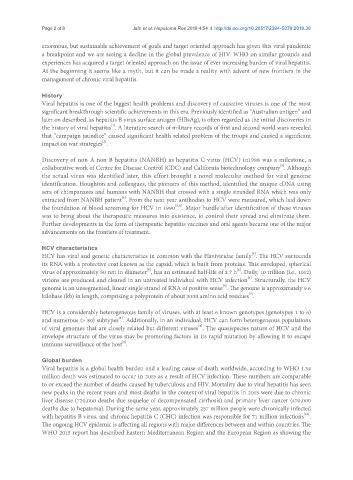Page 567 - Read Online
P. 567
Page 2 of 8 Jafri et al. Hepatoma Res 2018;4:54 I http://dx.doi.org/10.20517/2394-5079.2018.36
enormous, but sustainable achievement of goals and target oriented approach has given this viral pandemic
a breakpoint and we are seeing a decline in the global prevalence of HIV. WHO on similar grounds and
experiences has acquired a target oriented approach on the issue of ever increasing burden of viral hepatitis.
At the beginning it seems like a myth, but it can be made a reality with advent of new frontiers in the
management of chronic viral hepatitis.
History
Viral hepatitis is one of the biggest health problems and discovery of causative viruses is one of the most
significant breakthrough scientific achievements in this era. Previously identified as “Australian antigen” and
later on described, as hepatitis B virus surface antigen (HBsAg), is often regarded as the initial discoveries in
[1]
the history of viral hepatitis . A literature search of military records of first and second world wars revealed
that “campaign jaundice” caused significant health related problem of the troops and caused a significant
[2]
impact on war strategies .
Discovery of non A non B hepatitis (NANBH) as hepatitis C virus (HCV) in1988 was a milestone, a
[3]
collaborative work of Centre for Disease Control (CDC) and California biotechnology company . Although
the actual virus was identified later, this effort brought a novel molecular method for viral genome
identification. Houghton and colleagues, the pioneers of this method, identified the unique cDNA using
sera of chimpanzees and humans with NANBH that crossed with a single stranded RNA which was only
[4]
extracted from NANBH patient . From the next year antibodies to HCV were measured, which laid down
[5,6]
the foundation of blood screening for HCV in 1990 . Major hurdle after identification of these viruses
was to bring about the therapeutic measures into existence, to control their spread and eliminate them.
Further developments in the form of therapeutic hepatitis vaccines and oral agents became one of the major
advancements on the frontiers of treatment.
HCV characteristics
[5]
HCV has viral and genetic characteristics in common with the Flaviviridae family . The HCV surrounds
its RNA with a protective coat known as the capsid, which is built from proteins. This enveloped, spherical
[5]
[6]
virus of approximately 50 nm in diameter , has an estimated half-life of 2.7 h . Daily, 10 trillion (i.e., 1012)
[6]
virions are produced and cleared in an untreated individual with HCV infection . Structurally, the HCV
[5]
genome is an unsegmented, linear single strand of RNA of positive sense . The genome is approximately 9.6
[7]
kilobase (kb) in length, comprising a polyprotein of about 3000 amino acid residues .
HCV is a considerably heterogeneous family of viruses, with at least 6 known genotypes (genotypes 1 to 6)
[8]
and numerous (> 80) subtypes . Additionally, in an individual, HCV can form heterogeneous populations
[8]
of viral genomes that are closely related but different viruses . The quasispecies nature of HCV and the
envelope structure of the virus may be promoting factors in its rapid mutation by allowing it to escape
[9]
immune surveillance of the host .
Global burden
Viral hepatitis is a global health burden and a leading cause of death worldwide, according to WHO 1.34
million death was estimated to occur in 2015 as a result of HCV infection. These numbers are comparable
to or exceed the number of deaths caused by tuberculosis and HIV. Mortality due to viral hepatitis has seen
new peaks in the recent years and most deaths in the context of viral hepatitis in 2015 were due to chronic
liver disease (720,000 deaths due sequelae of decompensated cirrhosis) and primary liver cancer (470,000
deaths due to hepatoma). During the same year, approximately 257 million people were chronically infected
[10]
with hepatitis B virus, and chronic hepatitis C (CHC) infection was responsible for 71 million infections .
The ongoing HCV epidemic is affecting all regions with major differences between and within countries. The
WHO 2015 report has described Eastern Mediterranean Region and the European Region as showing the

